A good knife is an essential tool that helps you in your kitchen adventures. You must have noticed though, either in your mother’s kitchen or on your own, there is one knife that has been used for years and years for any kind of cutting and chopping. The knife has probably seen you crawl around like a little baby and will be around up to the point when you had a couple of young ones of your own.
Using the same knife for anything and everything might seem like the more economical option but know that this probably never gave the best results. Knives or knife sets are always designed to serve a particular purpose. While there are multipurpose knives available, know that there are going to be certain flaws that only the knife designed for that particular task can do best. This is why buying an entire set of knives that serve all purposes is necessary.
Knives can be classified into groups either based on their build or based on their functions. On the basis of their build, knives can be classified into two groups – forged knives and stamped knives. On the basis of their function, there are over 5 different types of knives.
Table of Contents
Types of Knives (On the Basis of Build)
Forged Knives
Forging a knife from a single piece of metal makes a forged knife. A block of steel is hammered into shape using a powerful hydraulic press or by hand in certain cases, before being sharpened to give a really strong cutting edge. A handle of a material of the maker’s choice is added to the knife before it is polished.
The steel is altered all the way down to a molecular level when forged, making the blade extremely strong. The entire blade and tang end up being made from a single piece of steel, making the blade extremely strong, durable and very well-balanced. These knives, however, are comparatively more expensive due to the amount of time and effort and that goes into making them. The advantage of using such knives is that they are extremely durable, and they last for years.
Stamped Knives
Stamped knives are made by cutting the shape needed out of a sheet of metal. The blade is hardened, polished and sharpened to give a perfect cutting edge. The handle is added at the same time.
These knives are fashioned out of thin sheets of metal, making them lighter than forged knives. The manufacturing process of these knives is much easier and faster resulting in affordable rates for these knives. Then again, the thin blade results in the knife not being able to retain its edge for long enough. These knives require frequent sharpening. The handle also can break off very easily in such knives.
Stamped knives have a bad reputation due to reduced durability and reduced ability to retain sharpness. However, modern stamped knife manufacturers have refined their technologies to produce knives that perform well even when put up against forged knives. This makes these knives the preferred knife in most professional chefs, thanks to their lightweight built and durability.
Types of Knives (On the Basis of Function)
Chefs’ Knife
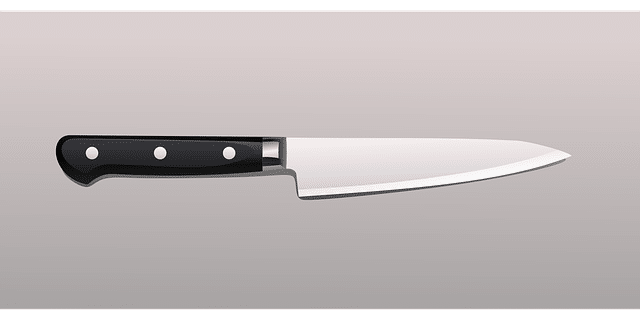
A chefs’ knife or cook’s knife — has a long, broad blade of about 10 inches (standard size) with a sharp cutting edge. A chefs’ knife is a multipurpose knife, perfect for everyday dicing and mincing tasks. It is wider towards the heel, tapering up to a finely pointed and sharp tip.
The blade of a chefs’ knife is slightly curved, facilitating a to and fro rocking motion of the knife which makes it easier to chop and dice a number of vegetables and fruits at one go. The wider heel of the blade allows for tougher chopping work because it can take up the pressure easily.
Utility Knife
A utility knife is the smaller and slimmer version of a chefs’ knife. Certain utility knives also have a sharp tip that tapers up towards the spine, to allow for more delicate and precise work.
A utility knife issued to cut smaller fruits and vegetables. It functions much like a chef knife but can deliver smaller and much more precise cuts. It is perfect for making smaller incisions, cuts or chops. It is also more suitable for young children starting out with cooking thanks to its small size and low weight.
Bread Knife
A bread knife has a very long, evenly sized blade, with a sharp serrated edge. This is designed for use on softer items.
The long blade and sharp serrated edge saws through all sorts of different breads, including crusty bread, baguettes, bagels, and bread rolls. The grooved edge allows the chef to cut through softer textures without crushing them out of shape by applying even pressure. Bread knives can also be used to slice soft and fluffy cakes as they can cut through them without damaging the overall shape. A bread knife can be used to level out your sponge cakes after baking.
A bread knife is an important baking tool used for baking and finishing baked products.
Paring Knife
A paring knife is a knife with an even smaller, evenly sized blade. It is light and easier to handle during delicate work.
The small paring knife can be used to cut, chop and slice fruits and vegetables. Although small in size, paring knives can absolutely dominate, even on harder foods, like potatoes, while still being flexible enough to perform delicate tasks like trimming, peeling, and removing seeds.
Butcher Knife/ Cleaver
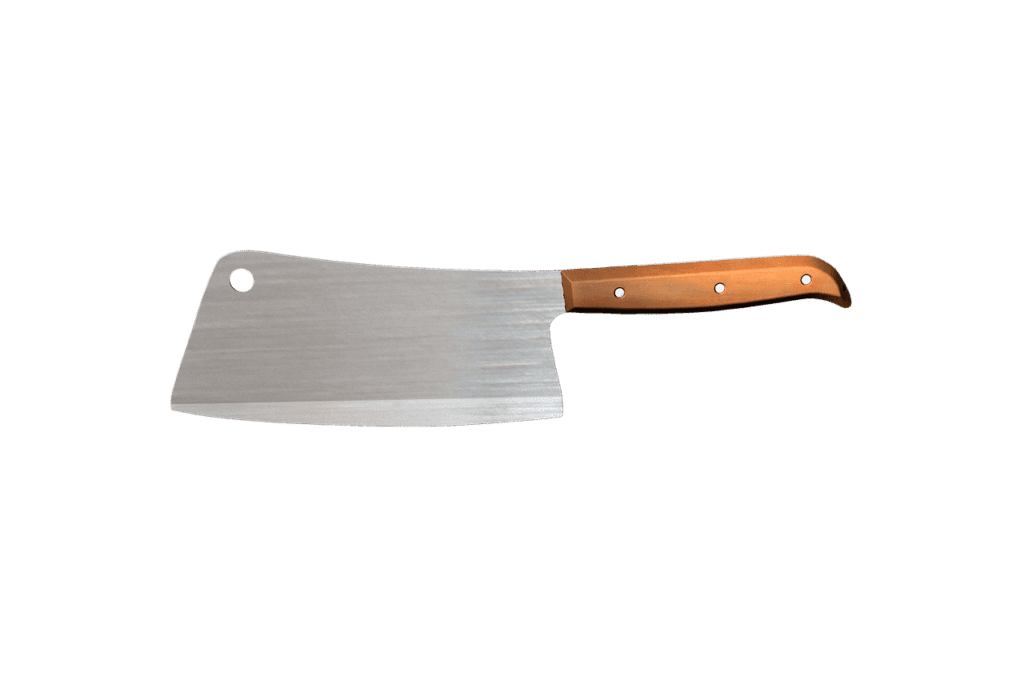
Cleavers or butcher knives have a large, flat blade that is rectangular in shape. Their size varies in accordance with their usage. They are broad, heavy knives, and sometimes feature a hole near the spine of the blade so you can hand it up when you are not using it. A cleaver is used to chop meat into smaller portions before cooking. The large, heavy design makes it easy to cut through bone, making it one of the best knives for raw meat butchery.
Due to its heavyweight and large size, it is only suitable for meat prep and not for fine chopping and dicing of fruits and vegetables. The broad, flat, heavy blade surface of cleavers can be used for crushing garlic cloves or ginger against the chopping board.
Boning Knife
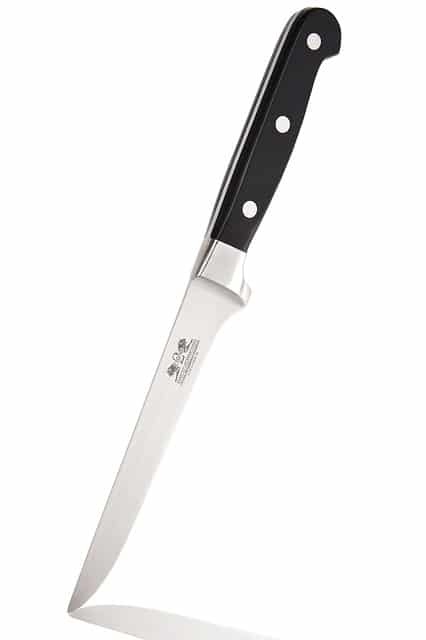
The boning knife is a thin blade with a very sharp edge, usually ending with a fine pointed tip moved slightly upwards. It’s a little short blade and is a strong one.
A boning knife is best suited for cutting meat bones and trimming cartilage before cooking. The pointed tip and slim blade make it easy to cut around the bone without absolutely destroying the meat around it. This blade can also be used to cut through cartilage. Boning knives are designed to be light, maneuverable, comfortable and easy to use.
Carving Knife
A carving knife is a long, slim knife with a tapered sharp point. It is also called a slicing knife. A carving knife is one of the longest kitchen knives in the kitchen. Its narrow width allows it to make cleaner, more uniform slices.
When it comes to serving meats like poultry, pork, lamb or beef, a carving knife will produce neat, thin, even-sized slices. It can also be used to tackle larger fruits and vegetables, such as melons, which can be difficult to slice through using smaller or wider knives.
Santoku Knife
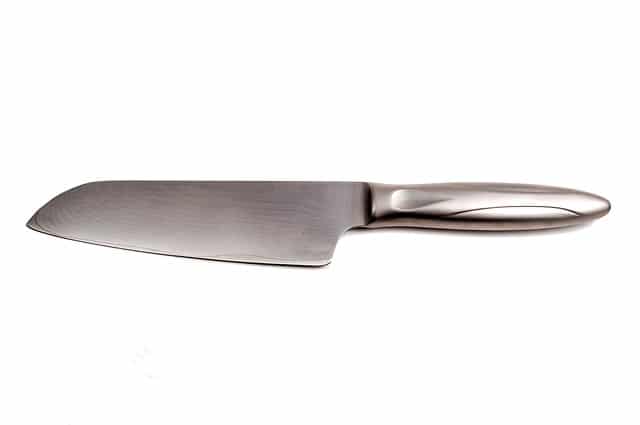
This is a type of Japanese knife. It was designed to closely resemble the traditional Japanese Nakiri but smaller for easier handling. It has a gently curved tip tapering downwards and helps create precise and proper cuts in one move. This knife is perfect for slicing, dicing, and chopping.
The Santoku is quite similar to the Chef knife with a few distinguishing factors.
Filleting Knife
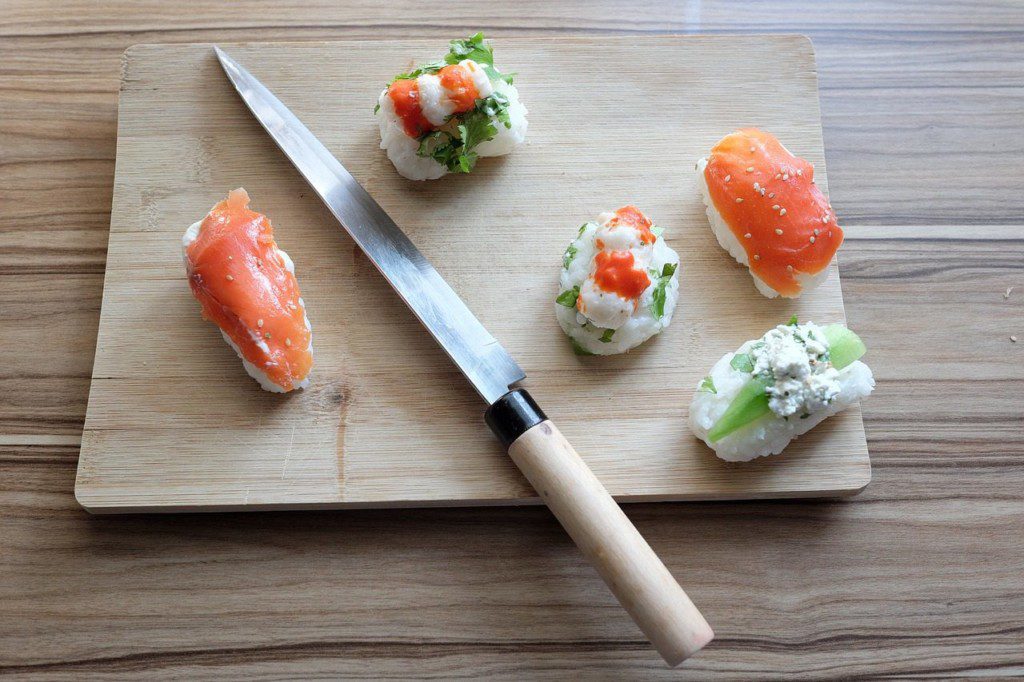
This is a long, slim knife with a flexible blade. It has a very sharp cutting edge along with an even sharper pointed tip for piercing through skin, bone-removal work really easy. It is similar to a boning knife, but the blade is thinner and more flexible.
The slim, flexible blade can remove bones without damaging the delicate flesh. The knife allows you to get perfect fillets by performing horizontal cuts as compared to vertical cuts like with most other knives.
Salmon Knife
Salmon knives are long double-edged knives that are designed to fillet larger fish. The sharp and slim Salmon knives facilitate precise filleting and skin.
A salmon knife is used to slice, fillet and remove the skin from larger fish. They fit between the flesh and skin of fish without damaging the fish making clean and precise fillets. They can be used to create precise fillets with minimal waste. Many salmon knives also have dimpling or indentations along the surface of the blade, which stops the raw fish from sticking to the blade.
Peeling Knife
The primary function of a peeling knife is to peel vegetables, fruits, etc. It is sharp enough to easily slice through the tough skin. The blade is rigid and sturdy, with ergonomic handles. This helps prevent the knife from slipping during peeling, making the process much safer.
Tomato Knife
Tomato knives are designed for cutting and slicing tomatoes. The smooth skin and soft fleshy pulp of tomatoes make it difficult to be cut with the help of regular knives. The serrated edge of the knife helps to cut through the skin without crushing the soft pulp, creating neat, even slices or segments. Most tomato knives are specially designed with textured plastic or rubber handles to give you a better grip during prep work.
Cheese Knife
Soft cheese tends to stick to knives while being cut. This is why cheese knives have holes in them. The holes reduce the surface area of knives in contact with the cheese, reducing the chances of cheese sticking to the knife. For harder cheese, the knife has to be sharp.
Related Reading
Mincing Knife
A mincing knife is a curved knife with two handles on either end of the blade. It is held by both hands. A rocking motion needs to be used to mince the vegetables, herbs, fruits or meat. This knife can mince food very fast with minimal efforts.
FAQs
-
What are the different types of blades in knives?
There are mainly four types of blades in knives.
Serrated Edge
A serrated edge has very sharp grooves and ridges all along the blade which help to cut harder foods. They can also slice softer foods without crushing them and putting them out of shape. Bread knives, tomato knives, etc have serrated edges.
Straight Edge
This is the most common type of edge. It is also known as a flat ground edge. It’s found on most knives including chefs’ knife, paring knife, etc.
Hollow Ground Edge
This type of edge is seen in most Japanese knives. Here the blade tapers down from the center of the blade to a very sharp cutting edge. These knives are extremely sharp but are prone to breaking and wear and tear. They need to be sharpened frequently.
Scalloped Edge
These types of blades have dimples along the length of the blade which prevents wet or sticky food items from sticking to the blade. This is especially useful when cutting foods like raw fish or sticky vegetables like lady’s fingers. -
What materials are knife blades made of?
Most knives are generally made of stainless steel but there are other materials also being used in knives.
Stainless Steel Blades
Stainless steel is the most popular material for knives. It has great durability and resistance to rust and corrosion. The alloy is made using carbon and iron, and chromium is added to make it resistant to stains and give the blade a lasting polished finish.The disadvantage of stainless steel is that there is a wide variety of alloys commercially available, so the quality of the steel is not consistent and can vary based on the supplier.
Stainless steel is a very commonly used material, especially for vessels like stainless steel kadhais, frying pans and pressure cookers are preferred at home thanks to their durability and their ease of cleaning.
Carbon Steel Blades
Carbon steel is made from carbon and iron, without the chromium. This is often used to make knives that require exceptional strength and rigidity. It can also retain its sharp edge when properly cared for.
However, since these blades don’t have the chromium, carbon steel blades are prone to staining and discoloration. This is seen especially when they come into contact with acidic foods. These blades don’t have the same shine and luster as stainless steel blades. But the sharpness and durability of the edge in a carbon steel blade are incomparable.Damascus Steel Blades
In Damascus steel, two or more alloys are hammered together to forge strong steel that has a distinctive wavy pattern. Originally invented in medieval Damascus, this type of steel has a long history, and has been used to create knives for hundreds of years. This metal is extremely strong, durable and sharp, and has a very sought after and beautiful appearance.The crafting process of this blade is meticulous leading to its bigger price tag. However, these make some very serious knives that last for years, making them highly sought after by professional chefs and collectors.
Titanium Blades
Titanium is one of the hardest materials on the planet. It is non-magnetic and naturally resistant to rust and corrosion. However, these blades tend to be less sharp and cannot retain sharpness for long, making them unfit for regular kitchen use.Ceramic Blades
Ceramic blades are made using hardened Zirconium dioxide. These blades are non-metallic and often coated with other materials for added strength and durability. These are lightweight and comparatively more hygienic. However, these blades are more prone to breaking and cracking which are a result of rough use and improper care. They also require specialized sharpening tools as regular whetstones or honing rods could damage the blades. They do have longer edge retention compared to other blades.
Different knives have different functions that suit them the best. While some of these are multipurpose, it is best to have at least three different types of knives which include one multipurpose knife, a bread knife and a thinner knife like the filleting knife.


